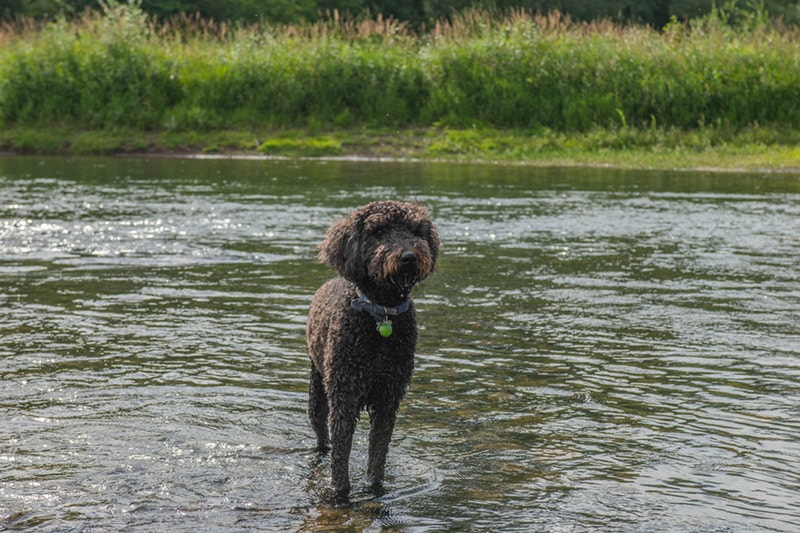Can Goldendoodles Swim? Facts & How To Teach Them

Updated on

The Goldendoodle combines two of the most amazing breeds, the Poodle and the Golden Retriever, and they require plenty of exercise and activities. Swimming is always a great way to exercise a medium to large breed dog without impacting their joints, but can Goldendoodles swim?
The answer is yes, they can swim, but they may need some encouragement. Both parent breeds are water dogs, so Goldendoodles have the skills but may still require some training to swim safely.
Can Goldendoodles Swim?
Since the parents of the Goldendoodle are both water-loving dogs, they have the skills and enthusiasm for swimming. The Goldendoodle also has webbed feet and a water-resistant coat that provides buoyancy and dries quickly. These characteristics make them an excellent breed for swimming.
However, like all dogs, some may enjoy it more or be more skilled at it than others, so they require encouragement in the beginning. Training is also vital to ensure your Goldendoodle is safe during water activities. Getting your Goldendoodle accustomed to water from a young age is also helpful so it is more familiar with water and swimming.

Do Goldendoodles Like to Swim?
Along with a natural skill for swimming, Goldendoodles are generally enthusiastic about swimming too and enjoy the water. From pools to lakes and even the beach, your Goldendoodle will most likely love the water. Especially when you start them off in the water early, they won’t hesitate to swim with you because it has been a part of their life from a young age. So, the more often you take your Goldendoodle to swim, the better.
It is important to note that this is also a generalization, as no two dogs are the same. If you want your Goldendoodle to be an avid swimmer, it will take early introductions, training, and some fun!
How to Teach Your Goldendoodle to Swim
Goldendoodles are praised for their intelligence, which makes them easy to train. They are eager to please their owners, which makes swimming lessons that much easier for trainers. Using positive reinforcement, it won’t take long for your Goldendoodle to respond to basic and advanced commands, and if you make it a fun and upbeat session, it won’t be long until your Goldendoodle is in love with the water.
When teaching your Goldendoodle to swim, it’s essential to start them off in a small, safe environment, in short sessions that grow gradually. A great place to start is a plastic kiddie’s pool. You can throw your Goldendoodles favorite toy in the shallow water and encourage your dog to retrieve it with treats and praise. Every time your Goldendoodle gets in and out of the water, reward it with a treat and make a big deal of what just happened. If your Goldendoodle is a bit resistant initially, try sitting in shallow water with it. Let your dog know it is safe to stand up in the water by being by its side the whole time. This will give your dog an extra sense of security and encourage it to spend more time in the water.
As your Goldendoodle gets more comfortable, you can increase the water level incrementally until it feels safe about jumping in and getting wet. However, ensure the pool has an exit, such as a ladder, so your dog can safely get out and doesn’t become exhausted from swimming around.

1. Safe Swimming
Safety should be your priority. First, completing a first aid course for pets can be so helpful as you never know what could happen, and being prepared and knowledgeable could save your dog’s life.
2. Supervise Your Dog
Never leave your Goldendoodle to swim unattended; even the strongest canine swimmer can run into a problem. Consider a life jacket if you are nervous or when your Goldendoodle is still learning. A life jacket can save your dog’s life by keeping it afloat if it gets too tired to carry on paddling or if it gets stuck in a current.
3. Limit the Time in the Water
Even though your Goldendoodle may love the water, swimming is strenuous, but because of the buoyancy of the water, it may be hard for your dog to realize how tired it is. Don’t allow your Goldendoodle to swim for too long, and keep a very close eye on them.
When your Goldendoodle is swimming for the first time, allow it to swim for only 5–10 minutes, and gradually increase the time as they gain more confidence. Always be mindful of your dog’s age, skill level, and size when swimming. A younger Goldendoodle may panic or get exhausted sooner, and an older dog may think it is stronger and more experienced than it is. Make sure you always have fresh water for your dog to rehydrate.

4. Be Mindful of the Temperature & Currents
Never allow your dog to swim in water you wouldn’t be comfortable swimming in. For instance, avoid swimming if the water or air temperature is too cold. When swimming in the sea or lakes and dams, be cautious of the tides and currents and any obstacles in the water, such as large rocks or large logs sticking out.
5. Rinse Your Dog Thoroughly After Swimming
Always give your Goldendoodle a rinse after swimming. Chlorine, salt water, and other pollutants can irritate your dog’s skin. Also, make sure you dry their ears thoroughly to avoid infection.
Conclusion
Goldendoodles are natural swimmers but require training and encouragement. However, not all Goldendoodles will react to water in the same way; some may be more apprehensive, while others won’t hesitate at all. If you want your Goldendoodle to be a swimmer, it’s important to expose them slowly and carefully to water from a very young age.
Safety should also be your number one concern when your Goldendoodle is swimming. Be mindful of its swimming abilities, signs that it’s tired, and the environment in which it is swimming, and don’t allow it to swim for too long. Always have fresh water on hand and make sure that every swimming session is a positive experience.
Featured Image Credit: Brandon Blake, Shutterstock










